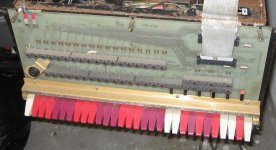Twylo
Experienced Member
Hey folks,
Well, I've been real busy on my PDP-11/35 for the last couple of months. I basically had to take the whole thing apart, down to the very last screw, clean everything, get the chassis sandblasted and powder coated, repair the power supply, and put it all back together. It was a lot of work, but it was worth it. And Tonight was The Big Night -- it was the first time that I powered it on with the CPU board set installed.
It did not work. Not that I expected it to, and yet I'm still somewhat disappointed, I guess.
Now, when I say "it did not work", what I mean is that it powered on, and nothing exploded. Random lights on the front panel latched on. The "Run" light was on, which was clearly a lie because it was not running. The only input that has any effect at all is the "Start" switch - when depressed and held down, all the LEDs dim just a little bit, and when it is released, a new seemingly random state appears on the front panel lights. That's something, I guess! No other front panel switches do anything.
Now, my first question for the group is, what is the absolute minimum possible configuration to debug the CPU in? Is it possible to bring up the CPU with no memory installed, just for testing?
For example, here's the configuration I tried:
System Backplane (9 Slots):
(For comparison, the original configuration as I received it is documented here: http://www.loomcom.com/blog/2012/04/30/pdp-1135-details/)
Is a Grant Continuity card required in 8D? I didn't think it was, but...
Even so, would a failure of grant continuity cause the symptoms I'm seeing? I really didn't think so.
Anyway, once I confirm whether this configuration is a valid test, I will move on and try to find a board extender so I can start digging into the logic a little.
This is intimidating!
-Twylo
Well, I've been real busy on my PDP-11/35 for the last couple of months. I basically had to take the whole thing apart, down to the very last screw, clean everything, get the chassis sandblasted and powder coated, repair the power supply, and put it all back together. It was a lot of work, but it was worth it. And Tonight was The Big Night -- it was the first time that I powered it on with the CPU board set installed.
It did not work. Not that I expected it to, and yet I'm still somewhat disappointed, I guess.
Now, when I say "it did not work", what I mean is that it powered on, and nothing exploded. Random lights on the front panel latched on. The "Run" light was on, which was clearly a lie because it was not running. The only input that has any effect at all is the "Start" switch - when depressed and held down, all the LEDs dim just a little bit, and when it is released, a new seemingly random state appears on the front panel lights. That's something, I guess! No other front panel switches do anything.
Now, my first question for the group is, what is the absolute minimum possible configuration to debug the CPU in? Is it possible to bring up the CPU with no memory installed, just for testing?
For example, here's the configuration I tried:
System Backplane (9 Slots):
- Empty
- Empty
- M7232 Micro Word Module
- M7231 Data Paths Module
- M7233 IR Decode Moduel
- M7235 Processor Status Module
- M7234 Timing Module
- Empty
- [A-B] M9302 Terminator, [C-F] M7800 Async Serial
(For comparison, the original configuration as I received it is documented here: http://www.loomcom.com/blog/2012/04/30/pdp-1135-details/)
Is a Grant Continuity card required in 8D? I didn't think it was, but...
Even so, would a failure of grant continuity cause the symptoms I'm seeing? I really didn't think so.
Anyway, once I confirm whether this configuration is a valid test, I will move on and try to find a board extender so I can start digging into the logic a little.
This is intimidating!
-Twylo

